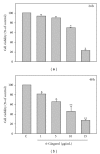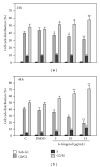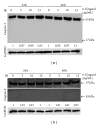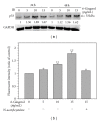6-Gingerol Inhibits Growth of Colon Cancer Cell LoVo via Induction of G2/M Arrest
- PMID: 22719783
- PMCID: PMC3375166
- DOI: 10.1155/2012/326096
6-Gingerol Inhibits Growth of Colon Cancer Cell LoVo via Induction of G2/M Arrest
Abstract
6-Gingerol, a natural component of ginger, has been widely reported to possess antiinflammatory and antitumorigenic activities. Despite its potential efficacy against cancer, the anti-tumor mechanisms of 6-gingerol are complicated and remain sketchy. In the present study, we aimed to investigate the anti-tumor effects of 6-gingerol on colon cancer cells. Our results revealed that 6-gingerol treatment significantly reduced the cell viability of human colon cancer cell, LoVo, in a dose-dependent manner. Further flow cytometric analysis showed that 6-gingerol induced significant G2/M phase arrest and had slight influence on sub-G1 phase in LoVo cells. Therefore, levels of cyclins, cyclin-dependent kinases (CDKs), and their regulatory proteins involved in S-G2/M transition were investigated. Our findings revealed that levels of cyclin A, cyclin B1, and CDK1 were diminished; in contrast, levels of the negative cell cycle regulators p27(Kip1) and p21(Cip1) were increased in response to 6-gingerol treatment. In addition, 6-gingerol treatment elevated intracellular reactive oxygen species (ROS) and phosphorylation level of p53. These findings indicate that exposure of 6-gingerol may induce intracellular ROS and upregulate p53, p27(Kip1), and p21(Cip1) levels leading to consequent decrease of CDK1, cyclin A, and cyclin B1 as result of cell cycle arrest in LoVo cells. It would be suggested that 6-gingerol should be beneficial to treatment of colon cancer.
Figures






Similar articles
-
Gallic acid induces G2/M phase arrest of breast cancer cell MCF-7 through stabilization of p27(Kip1) attributed to disruption of p27(Kip1)/Skp2 complex.J Agric Food Chem. 2011 Mar 9;59(5):1996-2003. doi: 10.1021/jf103656v. Epub 2011 Feb 7. J Agric Food Chem. 2011. PMID: 21299246
-
Silymarin and silibinin cause G1 and G2-M cell cycle arrest via distinct circuitries in human prostate cancer PC3 cells: a comparison of flavanone silibinin with flavanolignan mixture silymarin.Oncogene. 2006 Feb 16;25(7):1053-69. doi: 10.1038/sj.onc.1209146. Oncogene. 2006. PMID: 16205633
-
Decitabine, a DNA methyltransferases inhibitor, induces cell cycle arrest at G2/M phase through p53-independent pathway in human cancer cells.Biomed Pharmacother. 2013 May;67(4):305-11. doi: 10.1016/j.biopha.2013.01.004. Epub 2013 Feb 14. Biomed Pharmacother. 2013. PMID: 23582784
-
[6]-Gingerol enhances the radiosensitivity of gastric cancer via G2/M phase arrest and apoptosis induction.Oncol Rep. 2018 May;39(5):2252-2260. doi: 10.3892/or.2018.6292. Epub 2018 Mar 5. Oncol Rep. 2018. PMID: 29512739
-
1,25-Dihydroxyvitamin D3 induces differentiation of a retinoic acid-resistant acute promyelocytic leukemia cell line (UF-1) associated with expression of p21(WAF1/CIP1) and p27(KIP1).Blood. 1999 Apr 1;93(7):2225-33. Blood. 1999. PMID: 10090931
Cited by
-
Evaluation the cytotoxic effect of Fe3O4@Glu-Gingerol on lung adenocarcinoma cell line (A549) with biological mechanisms.Heliyon. 2023 Dec 10;10(1):e23419. doi: 10.1016/j.heliyon.2023.e23419. eCollection 2024 Jan 15. Heliyon. 2023. PMID: 38173472 Free PMC article.
-
[10]-Gingerol induces mitochondrial apoptosis through activation of MAPK pathway in HCT116 human colon cancer cells.In Vitro Cell Dev Biol Anim. 2015 Jan;51(1):92-101. doi: 10.1007/s11626-014-9806-6. Epub 2014 Aug 23. In Vitro Cell Dev Biol Anim. 2015. PMID: 25148824
-
Identification of the active substances and mechanisms of ginger for the treatment of colon cancer based on network pharmacology and molecular docking.BioData Min. 2021 Jan 11;14(1):1. doi: 10.1186/s13040-020-00232-9. BioData Min. 2021. PMID: 33430939 Free PMC article.
-
Inhibitory effect of herbal remedy PERVIVO and anti-inflammatory drug sulindac on L-1 sarcoma tumor growth and tumor angiogenesis in Balb/c mice.Mediators Inflamm. 2013;2013:289789. doi: 10.1155/2013/289789. Epub 2013 Jun 27. Mediators Inflamm. 2013. PMID: 23935247 Free PMC article.
-
[6]-Gingerol induces Caspase-Dependent Apoptosis in Bladder Cancer cells via MAPK and ROS Signaling.Int J Med Sci. 2022 Jun 21;19(7):1093-1102. doi: 10.7150/ijms.73077. eCollection 2022. Int J Med Sci. 2022. PMID: 35919815 Free PMC article.
References
-
- Chen LT, Whang-Peng J. Current status of clinical studies for colorectal cancer in Taiwan. Clinical Colorectal Cancer. 2004;4(3):196–203. - PubMed
-
- Kinzler KW, Vogelstein B. Lessons from hereditary colorectal cancer. Cell. 1996;87(2):159–170. - PubMed
-
- Mayer RJ. Targeted therapy for advanced colorectal cancer—more is not always better. New England Journal of Medicine. 2009;360(6):623–625. - PubMed
-
- Zbar AP, Kennedy PJ, Singh V. Functional outcome following restorative rectal cancer surgery. Acta Chirurgica Lugoslavica. 2009;56(2):9–16. - PubMed
-
- Surh YJ. Molecular mechanisms of chemopreventive effects of selected dietary and medicinal phenolic substances. Mutation Research. 1999;428(1-2):305–327. - PubMed
LinkOut - more resources
Full Text Sources
Research Materials
Miscellaneous

